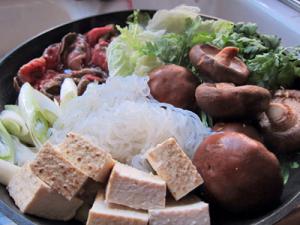
Sukiyaki, anyone? Sukiyaki is for the hearty and soulful appetite.
While millions of Americans happily enjoy sushi today as a favorite mainstay and trendy treat while dining out or in, my hearty appetite still belongs to the warmer dishes my Japanese-Hawaiian mother lovingly cooked for our family of six in our well seasoned and multicultural home.
Sukiyaki was our favorite traditional Japanese meal, also known as the Nabemono, meaning "Japanese Hot Pot Style" as savory ingredients are carefully and Zen-like placed in a large pot and allowed to simmer in a balanced orchestra of home-style tastes.
Savory ingredients include thinly sliced pieces of savory meats with an array of fresh vegetables cooked slowly in a marinade of soy sauce, sugar, and even sake, which has been known to add an overall sense of relaxation and calm.
This dish is best served in a shallow iron pot or electric skillet, and sometimes cooked and simmered on dining tables at restaurants and homes while everyone takes part in stirring and cooking. For me, this truly defined how families unite together, as my Eurasian sisters and I were expected to not only set the table, but prepare there as well. Talk about family inclusion!
Unbeknownst to many sushi aficionados and raw fish purists, Japanese cuisine is comprised of a wide variety of tasty meat dishes, usually sliced extremely thin and lean, unlike many American servings at restaurants and homes. Chicken and pork are also included in hundreds of soup, stew and even salad recipes in traditional Japanese meals.
Sauces and zesty marinades are also an integral part of recipes, handed down in my family for generations from my great grandmother, and now for me to cook for my own three "foodie" daughters. These may include thick and zesty teriyaki gravy, chicken broth and mouth-watering subtle ginger sauces, as well as countless other vegetable and meat stocks for soups, main dishes and celebratory feasts.

As a child, I recall smelling my mother's cooking from a block away as the aromas from our kitchen seemed to lift up our whole neighborhood with warmth. Even my friends asked if they could "please come over for dinner" as they named Sukiyaki their favorite dish.
Sukiyaki is formally known as a winter dish because of its warm, hearty flavors and is often served at Bonenkai, which are parties celebrated in Japan during the end of each year, although the main dish is welcomed all year long.
With kids back at school and long winter days ahead, this hot and hearty main dish is the perfect course for any family who wants a comforting and satisfying meal, and rivals any European, American or other exotic hearty stews that I have tried from all over the world.
Ingredients
Shallow large iron skillet or pan
Sukiyaki sauce
1/3 cup of Soy Sauce
3 Tbsp Sake
5 Tbsp Sugar
3/4 Cup Water
1 cup of Soup Stock (Chicken or Beef)
1 lb pound of beef, chicken or pork, sliced very thin
1 package of tofu, cut into 1 inch piece cubes
1 bunch of green onions, cut into 2-inch lengths
1 Negi or leek, cut into 2-inch lengths
8 Shitake mushrooms, sliced to desired size
1 package Shirataki noodles (made from cellophane noodles or yam cakes)
1 cup bamboo shoots
Directions
After cutting up meat, all vegetables and noodles, arrange them neatly on a large platter. Also mix together Sukiyaki sauce and set aside in a bowl.
Place skillet on medium to high heat on stove and heat 2-3 tablespoons of oil and allow to heat.
Then, carefully place the beef slices and marinade into the skillet and gently turn over. Never leave the stove.
You can also use an electric skillet and turn up to 375 degrees.
After meat looks slightly browned and the sauce begins to boil, slowly add the vegetables in one by one and gently stir. Turn down skillet from boiling point to a simmer and then allow all ingredients to simmer until all of the vegetables are soft.
Now it is time to enjoy this amazing feast that will surely become a favorite!
Other side dishes that can be served alongside include rice, vegetable tempura, and Japanese cucumber salad.
Enjoy! More recipes from my family coming soon!
Serves about three to five people, depending upon appetite. Double or triple the ingredient amounts and you can have a great dish to last all week! Just make sure to re-heat to a high temperature each time.
